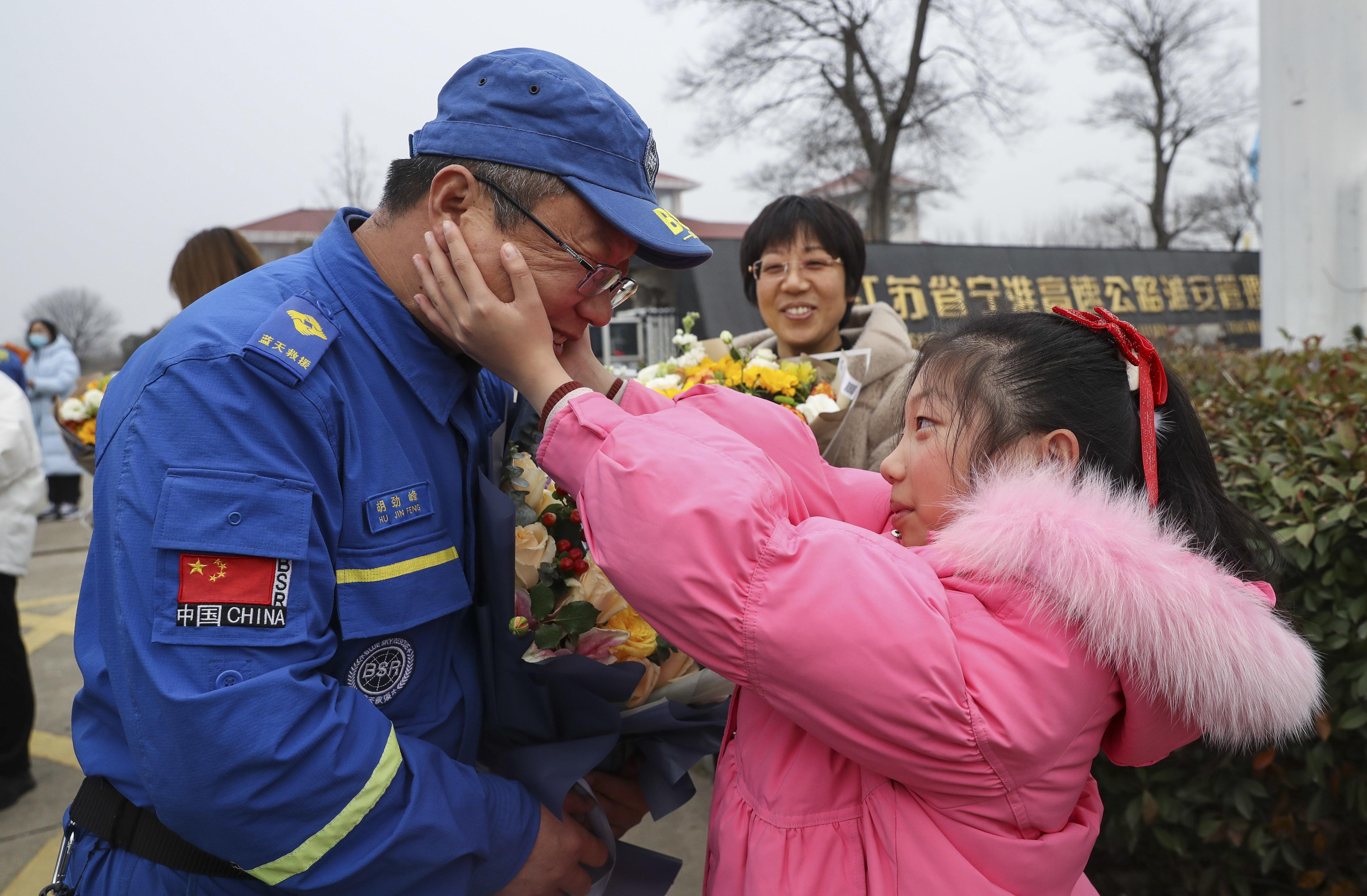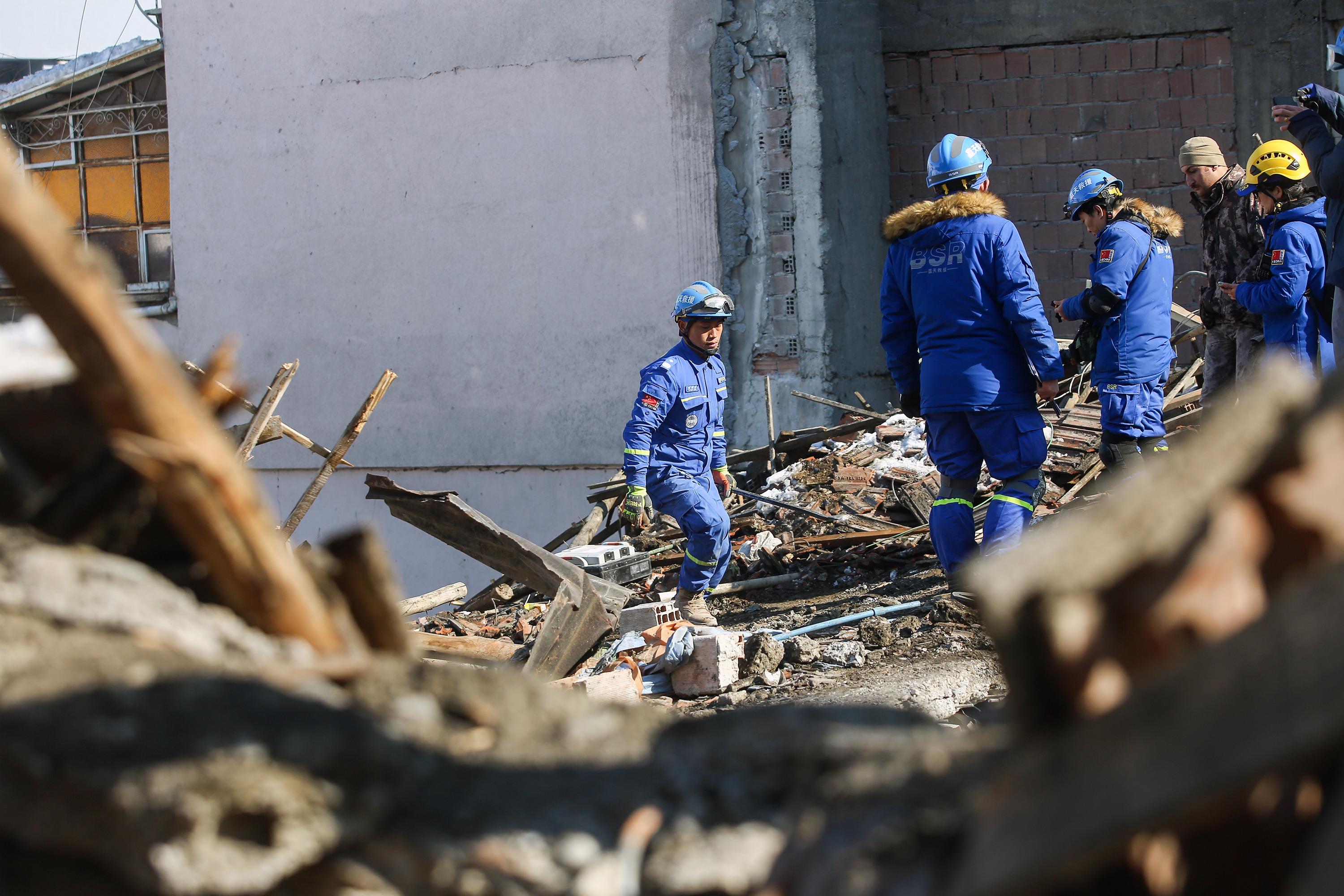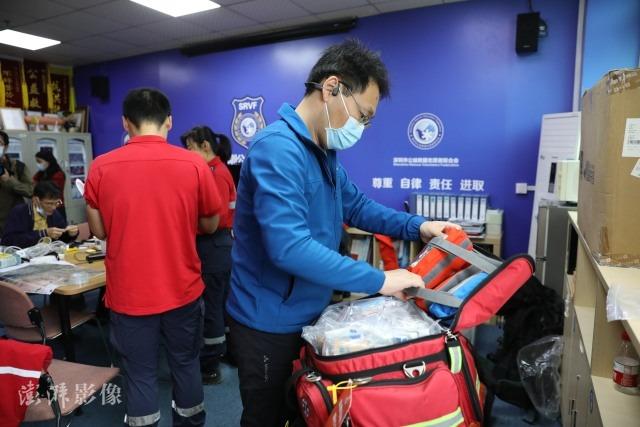The number of such groups has grown rapidly in China during the past 15 years as more people devote their time to relief efforts. Hou Liqiang reports.
 A BSR member is reunited with his family on Feb 18, when he returned from a rescue mission after an earthquake in Turkiye. (ZHAO QIRUI / FOR CHINA DAILY)
A BSR member is reunited with his family on Feb 18, when he returned from a rescue mission after an earthquake in Turkiye. (ZHAO QIRUI / FOR CHINA DAILY)
Wang Yi has mixed feelings when he recalls the time he spent in an earthquake-stricken area after a magnitude 8 temblor hit Wenchuan, Sichuan province, on May 12, 2008.
Along with many volunteers from across China, he went to the area with almost nothing but enthusiasm to save people, only to find that he could hardly do anything to help, he said.
However, there was a huge change in his emotions when he spoke about a rescue operation in Turkiye after a magnitude 7.8 earthquake struck the country and neighboring Syria on Feb 6.
The equipment his team carried was more advanced than that brought by many national rescue teams from other countries, said Wang, who was in charge of 304 members of the Blue Sky Rescue team in Turkiye. The BSR is China's largest humanitarian NGO.
With the aid of high-end equipment, including a drone that can supply constant light and various types of life-detection instruments, the team helped pull eight survivors and 137 bodies from the rubble.
 Members of the Ramunion, a civilian rescue team from China, carry a child pulled from earthquake rubble to a medical treatment facility in Hatay province, Turkiye, on Feb 9. (PHOTO PROVIDED TO CHINA DAILY)
Members of the Ramunion, a civilian rescue team from China, carry a child pulled from earthquake rubble to a medical treatment facility in Hatay province, Turkiye, on Feb 9. (PHOTO PROVIDED TO CHINA DAILY)
The changes Wang described are a microcosm of the development of China's civilian rescue teams during the past 15 years. Having started from scratch, they are now an important supplement to official emergency forces, even though many teams' operations still mainly depend on funding from their members, according to veteran rescuers and experts.
Although teams in some regions have managed to obtain support from local governments, many still need to explore how to continue their work in a sustainable way, they said.
Wang, a native of Guiyang, capital of Guizhou province, described the volunteers who headed to the quake-hit area in Wenchuan as "a herd of sheep without a shepherd".
Thanks to an introduction by one of his friends, Wang and nine other outdoor enthusiasts in Guiyang were offered seats on a cargo flight that was heading to Chengdu, Sichuan's capital, carrying emergency materials in the early hours of May 14, 2008.
In Chengdu, the team contacted volunteers from across the country via Tianya, an online discussion forum, and quickly managed to reach the affected area with the help of the local Red Cross.
 Members of China's Blue Sky Rescue team participate in relief efforts in Turkiye's Malatya province on Feb 10. (PHOTO PROVIDED TO CHINA DAILY)
Members of China's Blue Sky Rescue team participate in relief efforts in Turkiye's Malatya province on Feb 10. (PHOTO PROVIDED TO CHINA DAILY)
Sense of helplessness
Wang quickly discovered that most of the volunteers were carrying luggage rather than rescue equipment.
Though he had brought his mountaineering rope, it turned out to be useless for earthquake rescue, he recalled. However, one volunteer had a handheld GPS device. "Back then, that was quite advanced equipment for us," Wang said.
He recalled a strong sense of helplessness after reaching Hanwang, a township in Sichuan's Deyang city. On the day the volunteers arrived, the death toll in Deyang reached several hundred. The number shot up to more than 1,000 on the second day, then over 4,000 on the third, he said.
A huge pit was dug to accommodate the bodies. "One time, the other volunteers and I stood in a daze in front of the pit. I tortured myself again and again, asking myself if I'd had the ability to rescue people would at least one or two of them have been saved?" Wang recalled.
That sense of helplessness made the volunteers determined to establish a professional rescue team.
Thanks to joint efforts in different regions, the Blue Sky Rescue group was registered in Beijing in September 2010. The NGO now has 30,000 volunteers nationwide, it said.
Wang, head of the BSR's Guizhou branch, said the first piece of equipment they bought after returning from Sichuan was a static rope, which was used for high angle rescue operations in mountains and caves. It cost about 800 yuan, so 10 volunteers split the bill.
"The Guizhou BSR has equipment worth several million yuan," said Wang, a successful entrepreneur who has bought a lot of the equipment himself. He said the equipment — including pneumatic hammers, life detection devices and diving gear — means the team can undertake different types of tasks.
The rescue gear they carried to Turkiye helped win them the trust of local rescue teams. "Though some rubble had already been searched by teams from other countries, the local teams insisted that we searched again," Wang said.
Wang Kaibo, head of the BSR in Qinghai province who also went to Turkiye, said the radar life detector they carried could detect life signs precisely. "Some local residents and rescuers even came to us after midnight to seek help," he said, adding that the team's equipment has recently been greatly upgraded.
When the Qinghai BSR went to Yushu (in Qinghai) after it was hit by a magnitude 7.8 earthquake in April 2015, many members joked that they only had their courage and hands, he recalled, indicating the lack of advanced equipment back then.
 Personnel from the Shenzhen Rescue Volunteers Federation check their equipment and medication ahead of a rescue mission. (PHOTO PROVIDED TO CHINA DAILY)
Personnel from the Shenzhen Rescue Volunteers Federation check their equipment and medication ahead of a rescue mission. (PHOTO PROVIDED TO CHINA DAILY)
Many groups
The BSR was just one of 15 Chinese civilian rescue teams that joined the rescue operations in Turkiye. By 9 am on Feb 10, they had dispatched a total of 288 rescuers, according to the Ministry of Emergency Management. There was also an 82-member official Chinese team in Turkiye.
Like many other BSR members, Wang Yi and Wang Kaibo are veteran rescuers, as they have not only regularly undertaken training organized by the NGO, but have also taken part in many major rescue operations overseas since 2008.
For example, they were among 83 BSR members who went to Nepal after a magnitude 7.8 earthquake in April 2015. At least nine other Chinese civilian rescue teams also dispatched members to the country.
Yang Yanwu, secretary-general of the earthquake emergency rescue committee at the China Association for Disaster Prevention, said the Nepal earthquake marked the first large-scale participation of Chinese civilian rescuers in a disaster abroad.
"Since then, they have joined almost all major international disaster rescue operations," he said, adding that such organizations really started to play a role in China after the 2015 Yushu earthquake.
Yang noted the rapid development in the number of civilian rescuers in China and their rescue capabilities. By the end of last year, 4,011 civilian rescue teams had registered with his committee, he said, adding that the total number of members is estimated at 600,000 to 640,000.
Of those teams, about 50 have equipment worth more than 3 million yuan ($432,000). At least 10 are fully qualified to undertake international rescue operations in terms of their equipment, rescue skills, understanding of international rules and linguistic competence, he said, noting that only about 300 of the teams have permanent employees.
Civilian rescue teams operate effectively either because they have wealthy leaders with a lot of free time, great passion and competence, or because their leaders are good at obtaining support, he said.
However, the number of teams that operate efficiently is not very high, he said, adding that some members have even sold their houses to support their rescue work.
Last year, local authorities found that more than 130 of the civilian rescue teams registered with them had irregular operations, he said, adding that the actual number could be even higher.
For example, some were established by local volunteers who participated in rescue operations during the devastating flood in Zhengzhou, capital of Henan province, in July 2021. They quickly ceased operations because no further disasters happened in the area, Yang said.
He added that despite the rapid development in the past 15 years, China's civilian rescue teams are faced with challenges to their long-term development.
 BSR members work with local rescuers to help injured people in Malatya. (PHOTO PROVIDED TO CHINA DAILY)
BSR members work with local rescuers to help injured people in Malatya. (PHOTO PROVIDED TO CHINA DAILY)
Disaster prevention
Based on the development experiences of foreign civilian rescue teams, Yang said they should shift their focus to disaster prevention and mitigation.
"They should mainly work in their home areas and devote themselves to their local communities. This would be more cost-effective for them as they wouldn't have to travel long distances," he said.
Disaster prevention and mitigation services are in high demand at the grassroots level, and both governments and enterprises need to hire such services. The shift in focus would conform to the actual conditions for their long-term development, he said.
Some rescue teams have already managed to strike a balance between working for the public good and obtaining funds to maintain their operations.
The Shenzhen Rescue Volunteers Federation in Guangdong province is one of them. With over 2,000 volunteers and 700 uniformed rescuers — who have all undergone training and passed relevant tests — the group has mastered rescue techniques.
The team, which was officially established in 2008, has squads for mountain, urban, air and water rescue, medical services and emergency communications, said Shi Xin, the federation's head, adding that it has 11 full-time employees.
It takes roughly 2 million yuan a year to support the operations of such a team, said Shi, who is employed by a local transportation company.
Thanks to government procurement of services since 2015, the federation is not only able to maintain its operations, but it can also buy new equipment and provide regular training sessions for members.
For example, it offers training to local police and fire brigades in mobile communications, search techniques and water rescue, he said. It is also engaged in the management of emergency shelters and safety education in communities.
The federation is also supported by a number of foundations. With the support of the One Foundation, a public welfare foundation in Shenzhen, 22 of its members took part in the rescue operations in Turkiye in February.
The federation also joined the rescue operations for the 2015 Nepal earthquake, the 2018 Sulawesi earthquake and tsunami in Indonesia, and the collapse of a dam in Laos the same year.
"I think we do well. We do everything to the best of our abilities," Shi said.
Contact the writer at houliqiang@chinadaily.com.cn


